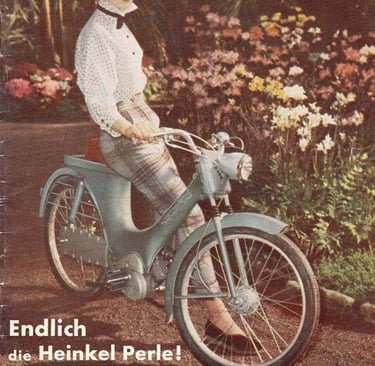From Skies to Streets: The Soaring Legacy of Heinkel
This article explores the legacy of Heinkel, a German engineering company known for its pioneering work in aviation. From manufacturing bomber aircraft during World War II to developing the world's first rocket aircraft and turbojet-powered aircraft, Heinkel made significant advancements in the field of aviation. However, after World War II, the company had to pivot its focus and ventured into producing mopeds, scooters, and bubblecars. The Heinkel Perle moped and the Heinkel Tourist scooter were particularly notable products that showcased the company's engineering excellence in the transportation industry.
MOPEDSVINTAGE MOPEDSGERMANY 1960'SHEINKEL
11/2/20233 min read


From Skies to Streets: The Soaring Legacy of Heinkel
Introduction
Heinkel, a name synonymous with German engineering, innovation, and versatility, has left an indelible mark in the annals of transportation. Founded by Ernst Heinkel, the company initially took to the skies as a pioneering aircraft manufacturing enterprise. Celebrated for its sophisticated bomber aircraft for the Luftwaffe during World War II, Heinkel was also at the forefront of high-speed flight. The Heinkel He 176, the first rocket aircraft, and the Heinkel He 178, the world's first turbojet-powered aircraft, were both trailblazing examples of its engineering prowess.
Heinkel in Aviation
In its illustrious aviation journey, Heinkel was synonymous with game-changing advancements and daring exploits. The Heinkel Flugzeugwerke, established at Warnemünde in 1922, made significant strides following a relaxation of the Treaty of Versailles restrictions on German aviation. The company's meteoric rise made Germany's presence felt in the global aerospace arena. By 1929, Heinkel's compressed air-powered catapults were being employed on German Norddeutscher Lloyd ocean-liners to catapult mail planes from the decks of these liners. The Heinkel He 178 and Heinkel He 176, successful liquid-fueled rocket and turbojet-powered aircraft respectively, veered the course of aviation history by achieving their maiden flights shortly before the outbreak of World War II.
Post-War Treaty and Its Impact
Post World-War II, the German industry faced staunch restrictions due to a treaty that sought to limit the potential for renewed militarization. The agreement forced several German businesses, including Heinkel, to pivot drastically away from their established ventures. For Heinkel, a company steeped in aeronautical engineering and aircraft manufacturing, this meant an abrupt abandonment of their previously successful domain.
Transition to Mopeds, Scooters, and Bubblecars
Faced with this dire situation, Heinkel showcased an uncanny ability to adapt and innovate under pressure. Drawing upon its rich engineering heritage, the company reinvented itself, venturing into the production of mopeds, scooters, and bubblecars. This pivotal shift not only allowed Heinkel to comply with the treaty's restrictions but also enabled it to carve out a new niche in post-war Germany’s burgeoning transportation market.
Spotlight on the Perle Moped
The Heinkel Perle moped emerged as one of their sterling offerings during this period. Befitting its name, 'Perle' or Pearl, this moped was one of the best-engineered machines of its time. Uniquely, it bore the distinct signature of Heinkel's aviation legacy. The Perle was constructed largely of aluminium, a testament to the company’s aeronautical engineering roots. The lightweight and durable metal was frequently used in aircraft manufacturing and offered added durability and weight benefits to the moped. Although its price was significantly higher than other market competitors when introduced to Great Britain, the Heinkel Perle’s advanced design and sheer quality assured its revered standing.
The Heinkel Tourist Scooter
Another noteworthy addition to the Heinkel lineup was the Heinkel Tourist scooter. Manufactured between 1953 and 1965, the Heinkel Tourist was perceived as an upscale scooter. It was heavier, more comfortable, and more stable compared to its contemporaries, offering premium features like a speedometer, a steering lock, a clock, a luggage carrier, and a spare wheel. Heinkel Tourists were even termed 'The Rolls-Royce of Scooters.' Notably, Heinkel's shift from aeronautical engineering to vehicle manufacturing led to innovations like these that left an indelible mark on the industry.
Conclusion
In retrospect, Heinkel's trajectory, shaped by the external milieu of wartime treaties and restrictions, is a testament to the company's resilience and adaptability. Gunpowder and propeller gave way to fuel and wheel, as Heinkel leveraged its aviation legacy to move away from the skies and onto the streets. The German dynamo successfully navigated the crosswinds of change, reinventing itself without losing its core: top-quality engineering. The iconic Heinkel Perle moped and the Tourist scooter remain enduring symbols of the company's inspiring journey from producing bombers to bubblecars.
